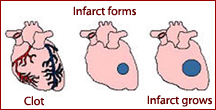Myocardial Infarction


Mechanism of Injury
A myocardial infarction (MI), or heart attack, occurs when a coronary artery is blocked, most commonly by a clot. This clot blocks blood flow, preventing oxygen from reaching part of the heart. Cells begin to die from lack of oxygen, creating a dying tissue mass called an infarct. Without treatment, this infarct grows and may result in life threatening complications due to its impact on cardiac function.
Maroon Biotech's Solution
The first priority in treatment is to restore blood flow. When blood flow is restored by reperfusion therapy, the sudden torrent of oxygen rich blood creates oxygen free radicals that increase the infarct damage. Injected concurrently with reperfusion therapy, surfactant chaperone treatment will reduce damage to heart tissue. Injecting surfactant chaperones prevents much reperfusion injury from occurring and heals cells damaged by lack of oxygen, actually reducing the size of the original infarct. Surfactant chaperone treatment will increase the likelihood of surviving a heart attack and decrease the incidence of post-heart attack complications such as a second heart attack or arrhythmia.


